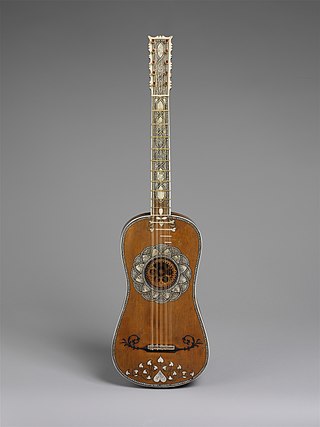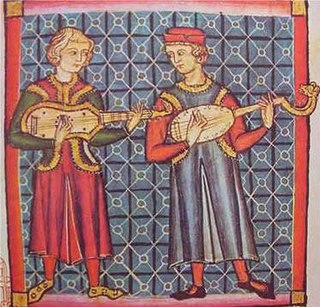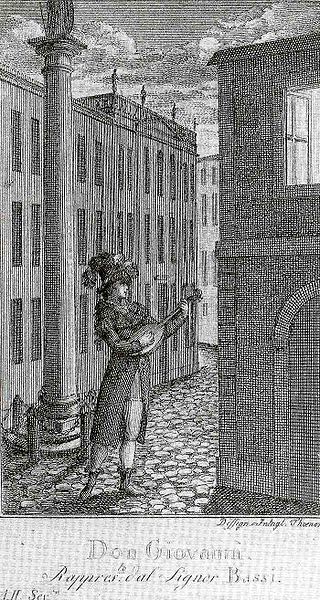This article needs additional citations for verification .(November 2012) |
The evolution of classical guitars began with the influences of the gittern and vihuela in the 16th century and ended with the modern classical guitar in the mid-19th century.
This article needs additional citations for verification .(November 2012) |
The evolution of classical guitars began with the influences of the gittern and vihuela in the 16th century and ended with the modern classical guitar in the mid-19th century.
While the precise lineage of the instrument is still unclear, historians believe that the guitar is the descendant of the Greek kithara, gittern, lyre, European and Middle Eastern lutes, and the Spanish vihuela. The poem The Book of Good Love [circa 1330] describes two early instruments, guitarra morisca and guitarra latina.
Instruments called "guitars" were first mentioned in literature in the 13th century, though many of these medieval records describe instruments that in modern times are classified as gitterns. [2] The first incarnation of what is now called the guitar first appeared during the Renaissance. The Renaissance guitar contained four pairs of strings called courses. The Renaissance guitar shared most similarities with the Spanish vihuela, a six-coursed instrument with similar tuning and construction. [3] Juan Bermudo in 1555 published Declaración de Instrumentos Musicales, a treatise containing a section on plucked string instruments. This publication examined the relationship between the guitar and vihuela, and also differentiated between four- and five-course guitars. The five-course guitar did not phase out the four-course instrument until the Baroque period.
One of the first major methods published for five-course guitar is Joan Carles Amat's Guitarra Española y Vandola en Dos Maneras de Guitarra, Castellana y Cathalana de Cinco Ordenes, [4] published in 1596. [5]
The vihuela became popular in Spain and Italy and remained common until the late 16th century. This instrument appears to have had a strong influence in the design and tuning of the early five-course guitars that first appeared in Spain in the middle of the 16th century. [6] These five-course guitarras replaced the four-course Renaissance instruments, particularly in Spain. The guitarra set the modern standard tuning – A, D, G, B, E – for the top five strings that continues to this day. [7] The number of frets on the guitar was increased from eight to ten and eventually to twelve. Later, it was in Italy that a sixth course became commonplace and this was an easily done by replacing or reworking the nut and bridge to plug in another tuning peg hole for the sixth string. An ornate guitar made by a Joakim Thielke (1641–1719) of Germany was altered in this way and became a success.
From the mid-18th century through the early 19th century, the guitar evolved into a six-string instrument, phasing out courses by preference to single strings. These six-string guitars were still smaller than the modern classical guitar.
The design of the modern classical guitar can be attributed to Antonio de Torres. The construction of these guitars has been considered the standard in "traditional" instruments since the mid-19th century.
Contemporary classical guitars follow the Smallman design which replaces the fan braces with a much lighter balsa brace attached to the back of the sound board with carbon fiber. The balsa brace has a honeycomb pattern and allows the (now much thinner) sound board to support more vibrational modes. This leads to greater volume and longer sustain.

The classical guitar, also known as Spanish guitar, is a member of the guitar family used in classical music and other styles. An acoustic wooden string instrument with strings made of gut or nylon, it is a precursor of the modern steel-string acoustic and electric guitars, both of which use metal strings. Classical guitars derive from instruments such as the lute, the vihuela, the gittern, which evolved into the Renaissance guitar and into the 17th and 18th-century baroque guitar. Today's modern classical guitar was established by the late designs of the 19th-century Spanish luthier, Antonio Torres Jurado.

The guitar is a stringed musical instrument that is usually fretted and typically has six or twelve strings. It is usually held flat against the player's body and played by strumming or plucking the strings with the dominant hand, while simultaneously pressing selected strings against frets with the fingers of the opposite hand. A guitar pick may also be used to strike the strings. The sound of the guitar is projected either acoustically, by means of a resonant hollow chamber on the guitar, or amplified by an electronic pickup and an amplifier.

The vihuela is a 15th-century fretted plucked Spanish string instrument, shaped like a guitar but tuned like a lute. It was used in 15th- and 16th-century Spain as the equivalent of the lute in Italy and has a large resultant repertory. There were usually five or six doubled strings.

A tiple, is a plucked typically 12-string chordophone of the guitar family. A tiple player is called a tiplista. The first mention of the tiple comes from musicologist Pablo Minguet e Irol in 1752. Although many variations of the instrument exist, the tiple is mostly associated with Colombia, and is considered the national instrument. The Puerto Rican version characteristically has fewer strings, as do variants from Cuba, Mallorca, and elsewhere among countries of Hispanic origin.

The bandurria is a plucked chordophone from Spain, similar to the mandolin and bandola, primarily used in Spanish folk music, but also found in former Spanish colonies.

The gittern was a relatively small gut-strung, round-backed instrument that first appeared in literature and pictorial representation during the 13th century in Western Europe. It is usually depicted played with a quill plectrum, as can be seen clearly beginning in manuscript illuminations from the thirteenth century. It was also called the guiterna in Spain, guiterne or guiterre in France, the chitarra in Italy and Quintern in Germany. A popular instrument with court musicians, minstrels, and amateurs, the gittern is considered an ancestor of the modern guitar and other instruments like the mandore, bandurria and gallichon.

The Baroque guitar is a string instrument with five courses of gut strings and moveable gut frets. The first course sometimes used only a single string.
An acoustic guitar is a musical instrument in the string family. When a string is plucked, its vibration is transmitted from the bridge, resonating throughout the top of the guitar. It is also transmitted to the side and back of the instrument, resonating through the air in the body, and producing sound from the sound hole. While the original, general term for this stringed instrument is guitar, the retronym 'acoustic guitar' – often used to indicate the steel stringed model – distinguishes it from an electric guitar, which relies on electronic amplification. Typically, a guitar's body is a sound box, of which the top side serves as a sound board that enhances the vibration sounds of the strings. In standard tuning the guitar's six strings are tuned (low to high) E2 A2 D3 G3 B3 E4.
The Harp Consort is an international early music ensemble directed by Andrew Lawrence-King, specialising in Baroque opera, early dance-music, and historical World Music.

The cythara is a wide group of stringed instruments of medieval and Renaissance Europe, including not only the lyre and harp but also necked, string instruments. In fact, unless a medieval document gives an indication that it meant a necked instrument, then it likely was referring to a lyre. It was also spelled cithara or kithara and was Latin for the Greek lyre. However, lacking names for some stringed instruments from the medieval period, these have been referred to as fiddles and citharas/cytharas, both by medieval people and by modern researchers. The instruments are important as being ancestors to or influential in the development of a wide variety of European instruments, including fiddles, vielles, violas, citoles and guitars. Although not proven to be completely separate from the line of lute-family instruments that dominated Europe, arguments have been made that they represent a European-based tradition of instrument building, which was for a time separate from the lute-family instruments.
Enríquez de Valderrábano was a Spanish vihuelist and composer. There is little biographical data on this composer of early music, but his Libro de música de vihuela intitulado Silva de Sirenas, published in Valladolid, Spain, in 1547, states he is a citizen of Peñaranda de Duero, and the book is dedicated to Francisco de Zúñiga, the Fourth Count of Miranda. This dedication is probably the source of Juan Bermudo's unconfirmed assertion in his Declaración de instrumentos musicales of 1555 that Valderrábano was employed by the count.

The mandore is a musical instrument, a small member of the lute family, teardrop shaped, with four to six courses of gut strings and pitched in the treble range. Considered a French instrument, with much of the surviving music coming from France, it was used across "Northern Europe" including Germany and Scotland. Although it went out of style, the French instrument has been revived for use in classical music. The instrument's most commonly played relatives today are members of the mandolin family and the bandurria.
A conchera or concha is Mexican stringed-instrument, plucked by concheros dancers. The instruments were important to help preserve elements of native culture from Eurocentric-Catholic suppression. The instruments are used by concheros dancers for singing at velaciones and for dancing at obligaciones.
Juan Bermudo was a Spanish Friar Minor who is best known as a composer, music theorist and mathematician.

The Colombian tiple is a plucked string instrument of the guitar family, common in Colombia where it is considered one of the national instruments. About three-fourths the size of a classical guitar, it has twelve strings set in four triple-strung courses. It is played as a main instrument or as an accompanying instrument to the guitar.
The Guitarra de golpe is a stringed musical instrument from Mexico. It has 5 nylon strings in 5 courses. The headstock traditionally has a traditional shape that is designed to look like a stylised owl with wooden pegs, but nowadays this is sometimes replaced with a guitar or vihuela style headstock with machine heads. For a while during the 20th century, the Guitarra De Golpe fell into disuse in traditional Mariachi groups, and was replaced by the Classical guitar. It has now however been revived. It is still an essential part of the "conjuntos de arpa" from Michoacán.

John Griffiths is a musician and musicologist specialised in music for guitar and early plucked instruments, especially the vihuela and lute. He has researched aspects of the sixteenth-century Spanish vihuela, its history and its music. He has also had an international career as a solo lutenist, vihuelist, and guitarist, and as a member of the pioneer Australian early music group La Romanesca. After a thirty-year career at the University of Melbourne (1980–2011), he now works as a freelance scholar and performer.

The Guitarra morisca or Mandora medieval is a plucked string instrument. It is a lute that has a bulging belly and a sickle-shaped headstock. Part of that characterization comes from a c. 1330 poem, Libro de buen amor by Juan Ruiz, arcipestre de Hita, which described the "Moorish gittern" as "corpulent". The use of the adjective morisca tacked to guitarra may have been to differentiate it from the commonly seen Latin European variety, when the morisca was seen on a limited basis during the 14th century.

Lutes are stringed musical instruments that include a body and "a neck which serves both as a handle and as a means of stretching the strings beyond the body".

The mandolin is a modern member of the lute family, dating back to Italy in the 18th century. The instrument was played across Europe but then disappeared after the Napoleonic Wars. Credit for creating the modern bowlback version of the instrument goes to the Vinaccia family of Naples. The deep bowled mandolin, especially the Neapolitan form, became common in the 19th century, following the appearance of an international hit, the Spanish Students. They toured Europe and America, and their performances created a stir that helped the mandolin to become widely popular.